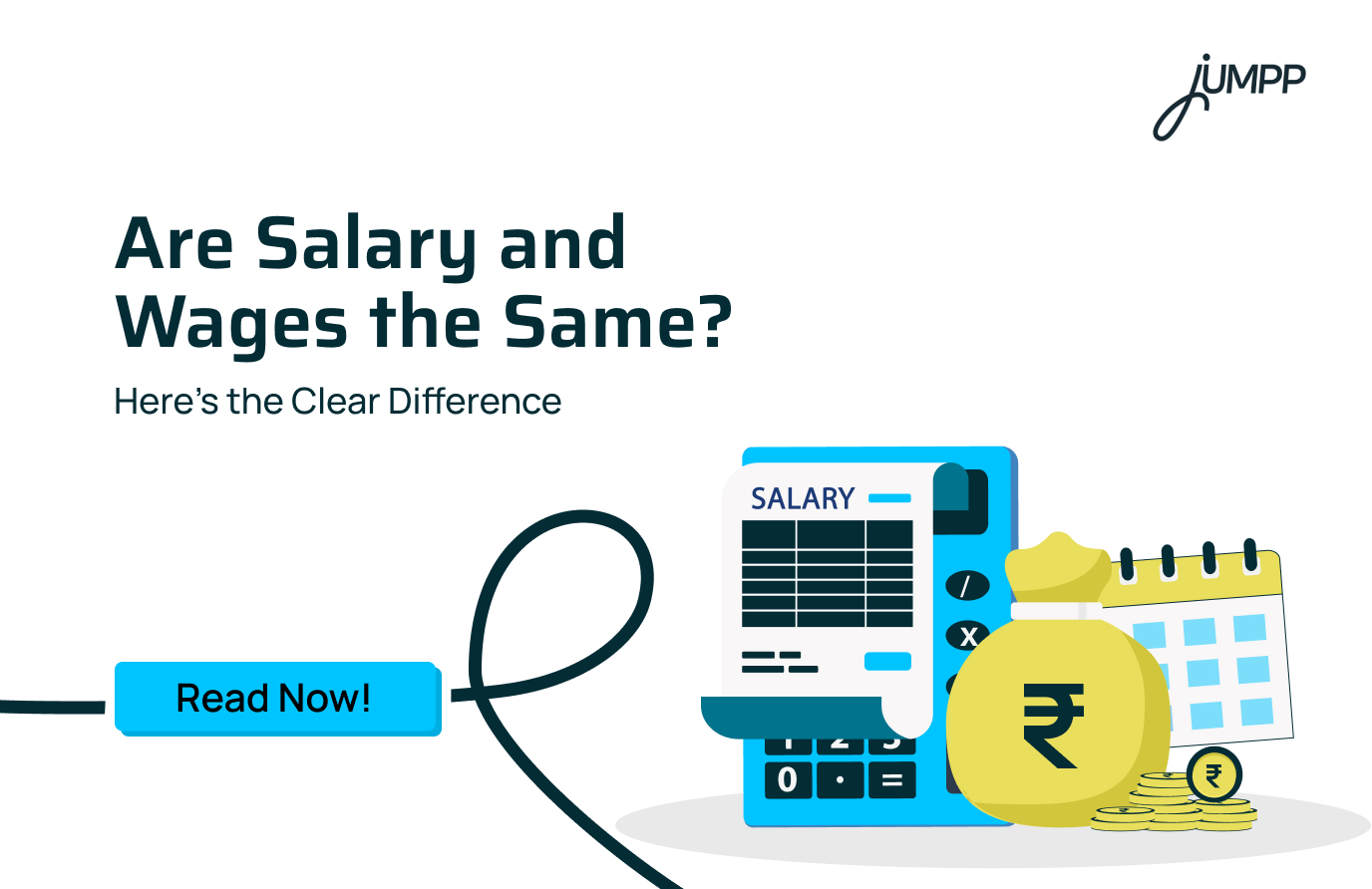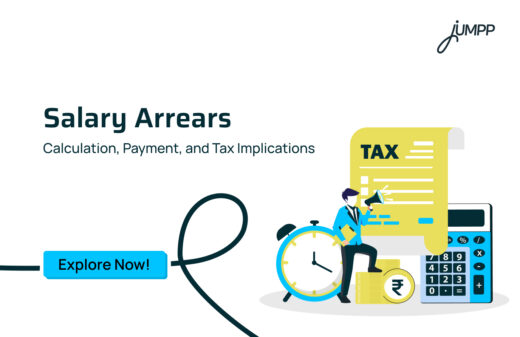Difference Between Wages and Salary: Key Points to Know

We have grown up with people around us using the terms’ salary ‘and’ wages’ interchangeably. But do you know that in reality, they carry very different meanings? Both are forms of compensation for work. But they apply to different types of employment, industries, and payment structures.
Today, we will introduce you to the real difference between wages and salary.
What is the Difference Between Salary and Wages
The key difference between wages and salary is that wages are payments calculated based on the hours or days worked. On the other hand, salary is a fixed amount paid over a set period. This could be usually monthly or annually.
Salary vs Wages- What is the Clear Difference Between Salary and Wages?
Wages fluctuate depending on the time spent working and are common in jobs involving unskilled or semi-skilled labour. Salary, on the other hand, is a consistent income.
| Basis | Wages | Salary |
| Payment Basis | Paid by the hour, day, or sometimes week. | Paid on a regular schedule, usually monthly. |
| Income Stability | Not fixed | Fixed |
| Overtime | Yes | Not fixed |
| Benefits | Limited | PF, paid leave, insurance, and bonuses. |
| Work Type | Unskilled or semi-skilled labour roles. | Professional, administrative, or managerial jobs. |
| Job Security | This is less secure and depends on the availability of work. | It is more secure, bound by contracts and a steady pay cycle. |
| Growth Opportunities | It is limited, depending on physical effort and hours worked. | There are higher chances of promotions, increments, and career growth. |
What are Wages?
Wages are payments made to workers based on the actual work they perform or the number of hours or days they spend working. These are directly linked to labour, productivity, or attendance.
How are Wages Calculated?
Wages are calculated in a simple way.
Employers first decide the total pay. It is often shown as an annual salary. After that, this annual pay is broken down based on your pay period. This could be monthly, weekly, or daily.
If you want to calculate an hourly wage, you can simply divide the total pay by the number of hours the employee works in a week.
Examples of Wages
To understand wages better, let’s take a practical example.
Ramesh works as a helper in a local hardware shop. His employer pays him ₹250 for every day he works. In one week, Ramesh works for 5 days.
So, his weekly wage will be:
Wage = ₹250 × 5 days = ₹1,250
If Ramesh misses a day, his wage automatically reduces. If he works on Sunday for extra hours, he earns additional pay.
Features of Wages
- Work-linked – Wages depend on work done or hours worked.
- Short-term payment – Wages are often calculated daily, weekly, or hourly.
- Variable income – The amount may change depending on attendance and performance.
- Mostly for workers or labourers – Wages are common in manual or semi-skilled jobs.
- Protected by law – The government ensures minimum wages to avoid exploitation.
Types of Wages
Wages are not the same everywhere. Different industries and legal systems classify wages in different ways.
Here are the main types of wages-
1. Minimum Wage
This is the lowest wage an employer is legally required to pay. It is designed to ensure workers can maintain their health, efficiency, and basic sustenance. For example, a daily wage worker in a state cannot be paid below the government-notified minimum wage for that industry or region.
2. Fair Wage
Fair wage falls between the minimum wage and the living wage. It depends on the three factors. These include the paying capacity of the industry, prevailing wage levels in the region, and the standard of living.
3. Living Wage
A living wage allows a worker to afford not just basic food, housing, and clothing but also healthcare, education for children, and some level of comfort. It reflects a more humane and socially just wage.
4. Time-Based Wages
Workers are paid according to the time they spend on the job. This is calculated on an hourly, daily, or monthly basis. For example, a construction labourer may be paid ₹500 per day, irrespective of how much work is completed.
5. Piece-Rate Wages
In this system, wages depend on output. If a worker is paid ₹10 per garment stitched, their total earnings will be based on the number of garments produced. This is common in textiles and small manufacturing units.
6. Overtime Wages
When employees work beyond their scheduled hours, they are entitled to overtime pay at a higher rate. For example, if the normal hourly wage is ₹200, overtime might be ₹300 per hour.
7. Contract Wages
This payment is made for completing a particular job or project, regardless of the time taken. A mason building a wall for ₹15,000 is an example.
Legal Framework for Wages in India
Wages in India are guided by law.
- The Minimum Wages Act, 1948
This law ensures that workers in scheduled industries receive a minimum wage, protecting them from exploitation and guaranteeing basic income security.
- The Code on Wages, 2019
This is a more recent and comprehensive law that consolidates earlier wage-related laws. It defines wages as basic pay plus dearness allowance (DA), while excluding bonuses, HRA, and other allowances. It sets a uniform legal framework across industries and states for minimum wage and payment rules.
What is Salary?
Salary is a fixed and regular payment made to an employee for their services, usually on a monthly basis. Unlike wages, salary does not vary with the number of hours worked or the direct output delivered.
Salary is more common in white-collar jobs such as offices, banks, IT companies, government services, and teaching professions.
How are Salaries Calculated?
The calculation is done in two steps:
1. Gross Salary Calculation
Gross Salary = CTC – EPF – Gratuity
Here,
- CTC (Cost to Company) is the total package offered by the employer.
- EPF (Employees’ Provident Fund) and Gratuity are mandatory deductions made by the employer.
2. In-Hand Salary Calculation
In-hand Salary = Gross Salary – Income Tax – EPF – Professional Tax
This is the final amount that gets credited to your bank account every month.
Examples of Salary
Now let’s look at a salaried employee.
Sunil is a junior accountant at a trading company. He agreed on a monthly package of ₹28,000, which includes basic pay, HRA, and allowances.
His salary slip shows:
- Gross Salary = ₹28,000
- Deductions (PF + Professional Tax) = ₹3,000
- Net (In-hand) Salary = ₹25,000
Even if Sunil works fewer hours one week or puts in extra hours another week, his salary remains fixed.
Features of Salary
- Fixed and stable – Salaries are pre-decided and do not change frequently.
- Paid monthly – Employees usually receive salaries once a month.
- Associated with professionals – Salary is common in managerial or skilled professions.
- Includes benefits – Salaries often come with perks such as a provident fund, bonuses, medical insurance, and leave.
Types of Salary
These categories will help you understand how salary is broken down into different parts:
1. Basic Salary
This is the core of an employee’s pay. It is a fixed amount agreed upon between the employer and employee. The basic salary is the amount before adding allowances or making any deductions.
2. Gross Salary
Gross salary is the total earnings before any deductions by your employer. It includes the basic salary along with allowances such as HRA (House Rent Allowance), DA (Dearness Allowance), medical allowance, incentives, and bonuses.
If your basic is ₹30,000 and you also get ₹10,000 in allowances, then your gross salary is ₹40,000.
3. Net Salary (In-hand Salary)
Net salary is the amount that is actually credited to your bank account after all the deductions. Now, these deductions, for instance, could include your monthly provident fund (PF), professional tax, TDS (income tax), etc.
For example, if your gross salary is ₹40,000 and deductions are ₹5,000, your net salary is ₹35,000.
Types of Salary Based on Payment Structure
1. Hourly Package
Some organisations may hire you as a part-time employee. In that case, you are paid based on the hours you work on a weekly or monthly basis.
2. Commission-Based Pay
Here, your salary depends on performance or results achieved. In India, this is basically applicable for sales jobs.
Sales representatives, for instance, may receive a base salary plus commissions for every deal closed. A real estate agent may earn ₹20,000 base pay plus 2% commission on sales.
Other Salary Components that You Should Know
1. Allowances: These are extra payments made to cover specific expenses. These could include HRA (for rent), DA (to adjust for inflation), conveyance allowance (for travel), and medical allowance.
2. Incentives and Bonuses: These are the rewards for achieving performance targets or contributing to company goals. You may also receive a Diwali bonus or a performance bonus.
3. CTC (Cost to Company): This is the total amount a company spends on an employee. It includes gross salary plus employer contributions like PF, gratuity, insurance, and other perks.
Know more about what is CTC in detail!
Salary vs Wages- Pros and Cons
While salary and wages serve the same purpose, i.e., earning income. However, they impact your stability, growth, and flexibility differently.
Here’s a look at their pros and cons.
Pros and Cons of Salary
Pros
- A fixed monthly income ensures financial stability.
- It comes with extra benefits like PF, insurance, and bonuses.
- You have regular working hours.
- It is easier to plan for long-term savings and investments.
Cons
- There is no extra pay for working additional hours (unless overtime policy applies).
- There is a limited flexibility in working hours.
- Salary does not grow unless there is a promotion or appraisal
Pros and Cons of Wages
Pros
- The payment is directly linked to work done (more hours = more pay).
- You may get flexible work schedules in some jobs.
- It offers an easier entry for unskilled or semi-skilled workers.
- You get to earn on a daily or weekly basis.
Cons
- There is no fixed income security (depends on days worked).
- You get only few or no benefits like PF or insurance.
- Work may be irregular.
- It is harder to plan for future savings.
Which is Better- Salary or Wages
Salaries offer stability, financial security, and additional perks such as a provident fund, paid leave, and bonuses. This makes them suitable for people seeking a steady income and career growth.
On the other hand, wages provide flexibility and quick earnings. It is often on a daily or hourly basis. These features make wages useful for those who prefer short-term payments or need immediate cash flow.
However, in the long run, a salaried job is usually considered more advantageous as it not only ensures consistent monthly income but also supports financial planning, savings, and access to employee benefits.
Conclusion
Both wages and salaries represent ways in which workers are compensated. But they apply to different categories of jobs. Wages are linked to labour and time, whereas salaries are fixed monthly payments for professional work.
In India, laws protect both wage earners and salaried employees to ensure fair treatment.
Difference Between Wages and Salary- FAQs
Wages are linked to the number of hours or days worked, so they can change each pay cycle. Salary, on the other hand, is a fixed and regular amount paid monthly or biweekly, regardless of the exact hours worked.
Wages are commonly paid daily or weekly, while salaries are usually credited once a month or sometimes biweekly.
Wages are more common among unskilled or semi-skilled workers, like daily labourers or helpers. Salaries are usually paid to skilled or professional employees working in offices or corporate setups.
Yes, wages depend on how many hours or days are worked. If a worker misses a day, earnings drop. Salaries stay fixed unless there is a promotion, increment, or deduction.
Yes. Salaried employees usually get benefits like paid leave, insurance, and more job stability. Wage earners may not receive these perks and often face less security.
A salary offers you a predictable income, financial stability, and benefits. Wages may provide more flexibility, but they are less reliable and often don’t include additional perks.
Yes, the jobs in construction, agriculture, and temporary work arrangements often pay wages. On the other hand, corporate, professional, and managerial roles usually follow a salary-based structure.






